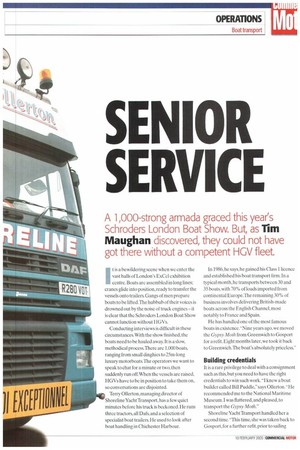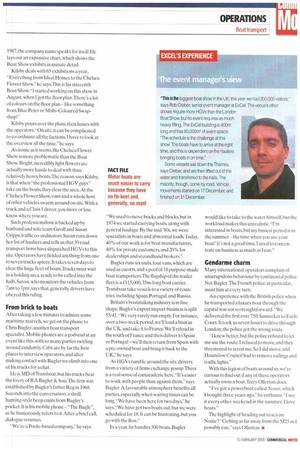SENIOR SERVICE
Page 57

Page 58

Page 65

If you've noticed an error in this article please click here to report it so we can fix it.
A 1,000-strong armada graced this year's Schroders London Boat Show. But, as Tim
Maughan discovered, they could not have
got there without a competent HGV fleet.
It is a bewildering scene when we enter the vast halls of London's ExCel exhibition centre. Boats are assembled in long lines; cranes glide into position, ready to transfer the vessels onto trailers. Gangs of men prepare boats to be lifted.The hubbub of their voices is drowned out by the noise of truck engines—it is clear that the Schroders London Boat Show cannot function without HG Vs.
Conducting interviews is difficult in these circumstances.With the show finished, the boats need to he hauled away. It is a slow, methodical process.There are 1,000 boats, ranging from small dinghies to 25m-long luxury motorboats.The operators we want to speak to chat for a minute or two, then suddenly run off When the vessels are raised. HGVs have to be in position to take them on, so conversations are disjointed.
Terry 011erton, managing director of Shoreline YachtTransport, has a few quiet minutes before his truck is beckoned. He runs three tractors, all Dafs, and a selection of specialist boat trailers. He used to look after boat handling in Chichester Harbour. In 1986, he says, he gained his Class 1 licence and established his boat transport firm. In a typical month, he transports between 30 and 35 boats, with 70% of loads imported from continental Europe.The remaining 30% of business involves delivering British-made boats across the English Channel, most notably to France and Spain.
He has handled one of the most famous boats in existence. "Nine years ago, we moved the Gypsy Moth from Greenwich to Gosport for a refit, Eight months later, we took it back to Greenwich.The boat's absolutely priceless."
Building credentials
It is a rare privilege to deal with a consignment such as this, but you need to have the right credentials to win such work."1 knew a boat builder called Bill Puddle," says 011erton."He recommended me to the National Maritime Museum. I was flattered, and pleased,to transport the Gypsy Moth."
Shoreline YachtTransport handled her a second time. "This time, she was taken back to Gosport, for a further refit, prior to sailing round the world again like she did in the mid1960s."
011erton's mobile phone rings. He takes the call and has quickly secured a deal to shift yet another boat.
This is the second year the London Boat Show has been held at ExCel,which is in the heart of London's Docklands. It seems a natural location for the event:a quay stands next to the exhibition hall, which in turn leads to the tidal Thames. Previously, the event was held at Earls Court exhibition centre.
In addition to the vessels in the halls, 30 boats and ships were moored at the quay, including a Royal Navy warship. Clearly, a ship of this size (133m long and with a displacement of 4.900 tonnes) can't be carried on a whole fleet of trucks, but it would be impossible to assemble the 1,000 boats without HGV traction. Earls Court, says 011erton, was a "logistical nightmare". ExCel makes life easier for the haulier, because HGVs can avoid heavily built-up residential areas, and there is enough parking space to accommodate large numbers of trucks. At Earls Court vehicle movements had to be timed to the second, because HGVs could not park on the site before loading and unloading.
Six men secure harnesses to a boat before two cranes lift it into the air. 011erton has to place his tractor and trailer underneath it. Before that, Shoreline personnel prepare to take on the precious cargo.
There is a real sense of urgency. 011erton and his team place blocks at vital points along the trailer, and they must be in exactly the right position.This particular sailing boat —14m long, 4.5m in breadth, and weighing 14 tonnes —has a bulky keel. Slowly,the cranes lower the vessel onto the traller.The keel fits into a well. The mast is attached alongside the traller.The boat is secured, then truck, trailer and vessel are on their way.This load is destined for a main boat agent in Southampton.
Meanwhile, other operators' trucks drive around the halls Outside, we clap eyes on a distinctive orange unit, operated by Gilbert Brown & Son Haulage. We visited this firm nearly three years ago. It is based in the village of Hawkshead, which lies between Windermere and Coniston Water.
Our conversation takes place in a Brown unit.Andy Brown, managing director, updates us with information on his company."We run a rigid and four units. We're boat transport specialists; and we do a bit of timber as well," he says:The firm dropped 12 boats at ExCel and will take 16 away from the site. "The Boat Show can be organised chaos, because there are a lot of trucks fighting to get the boats at the same time," he says.
Brown's biggest truck grosses at 38 tonnes In this sector, weight is not the central issue. Rather, the work is characterised by strict attention to detail, the knack of handling cumbersome loads — and delivering them in pristine condition.At the Boat Show, patience is most definitely a virtue. It takes time to collect 1,000 boats."When we first started at the Boat Shows, we used to get wound up with the waiting," says Brown. "This morning we should have loaded five boats by 10am. Now it's 3pm and we have collected four; this is par for the course."
Holiday seasons
The Boat Show is a hectic time for the likes of Brown, but his busiest period is Easter when boat owners want their vessels in situ,ready for the warm weather. "Half of the loads are motorboats, and half are sailing boats. Motorboats are much easier to carry, because they have no large fin keel and no mast."
The "V" shaped hull of motorboats allows them to be dropped onto trailers with minimum fuss. Interestingly, though, the size and width of boats dictates the rate, not the amount of hassle the operator must go through to handle and transport them.
CM exits Brown's truck and heads back into one of the halls — one contains motorboats, the other sailing boats. It is true that operators must put up with lengthy waits, but there has to be a marshalling system. If not, it would be a free-for-all with HGVs,men, harnesses and boats scrambling around unchecked.
The lofty figure of Gerry Kilsby appears. He is managing director of Exhibition Traffic Management Services. Founded by Kilsby in 1987, the company name speaks for itselille lays out an expansive chart, which shows the Boat Show exhibits in minute detail.
Kilsby deals with 65 exhibitions a year, -Everything from Ideal Homes to the Chelsea Flower Show.he says.This is his sixteenth Boat Show.-I started working on this show in August, when I got the floor plan.There's a lot of colours on the floor plan like something from Blue Peter or Multi-Coloured Swapshop!"
Kilsby pours over the plans, then liaises with the operators."On site, it can be complicated to co-ordinate all the factions. I have to look at the overview all the time," he says.
As ironic as it seems, the Chelsea Flower Show is more problematic than the Boat Show. Bright,incredibly light flowers are actually more hassle to deal with than relatively heavy boats. The reason, says Kilsby, is that when "the professional HGV guys" take on the boats, they clear the area. At the Chelsea Flower Show, vans and a whole host of other vehicles swarm around on site, With a truck and a Class 1 driver, you more or less know where you are.
Such professionalism is backed up by husband and wife team Geoff and Susan Cripps, traffic co-ordinators, Susan runs down her list of hauliers and tells us that 39 road transport firms have dispatched HGVs to this site. Operators have fielded anything from one to seven trucks apiece. It takes seven days to clear the huge fleet of boats.Trucks must wait in a holding area,ready to he called into the halls. Susan, who monitors the vehicles from 7am to 7pm, says that, generally, drivers have obeyed this ruling.
From brick to boats After taking a few minutes to admire some maritime marvels, we get on the phone to Chris Bugler. another boat transport specialist. Mobile phones are a godsend at an event like this, with so many parties swirling around randomly. Cabs are by far the best places to interview operators, and after making contact with Bugler we climb into one of his trucks for a chat.
He is MD of Transboat but his trucks bear the livery of RA Bugler & Son.The lirm was established by Bugler's father Reg in 1968. Seconds into the conversation, a shrill hunting-style beep emits from Bugler's pocket. It is his mobile phone -"The Bugle", as he humorously refers to it.After a brief call, dialogue resumes.
-We're a Poole-based company" he says. "We used to move bricks and blocks, but in 1974 we started carrying boats, along with general haulage. By the mid '80s, we were specialists in boats and abnormal loads.Today, 40% of our work is for boat manufacturers, 40% for private customers, and 20% for dealerships and secondhand brokers."
Bugler runs six units, four vans, which are used as escorts, and a pool of 18 purpose-made boat transporters.The flagship of the trailer fleet is a £115,000,35m-long boat carrier. Transboat take vessels to a variety of countries, including Spain,Portugal,and Russia.
Britain's boatmaking industry is in line shape. Bugler's export/import business is split 55/45." We very rarely run empty. For instance, over a two-week period, we'll load a boat in the UK,and take it to France. We'll reload in the south of France and then deliver to Spain or Portugalwe'll then return from Spain with a pre-owned boat and bring it back to the UK," he says.
As HGVs rumble around the site, drivers from a variety of firms exchange gossip.There is a real sense of camaraderie here. "It's easier to work with people than against them," says Bugler.A favourable atmosphere benefits all parties, especially when waiting times can be long. 'We have been here for two days," he says."We have got two boats out, but we were scheduled for 18. It can be frustrating, but you go with the flow."
In a year, he handles 500 boats. Bugler would like to take to the water himself, but the workload makes this unrealistic. "I'm interested in boats,but my busiest period is in the summer the time when you use your boat! It's not a good time, I need to concentrate on business as much as I can."
Gendarme charm Many international operators complain of unscrupulous behaviour by continental police. Not Bugler:The French police, in particular, assist him at every turn.
An experience with the British police when he transported a luxury boat through the capital was not so straightforward. "We delivered the first ever 75ft Sunseeker to Earls Court. It took us seven hours to drive through London; the police got the wrong route.
"I knew better, but the police refused to let me use the route. I refused to move, and they threatened to arrest me. So I did move, and Hounslow Council had to remove railings and traffic lights."
With this legion of boats around us, we're curious to find out if any of these operators actually owns a boat.Terry 011erton does.
-I've got a powerboat called Nonie, which I bought three years ago," he enthuses. "I use it every other weekend in the summer; I love boats."
The highlight of heading out to sea on Nonie? "Getting as far away from the M25 as I possibly can," says 011erton. •






































































































































































































